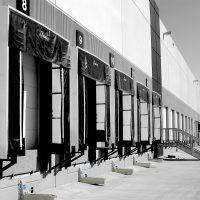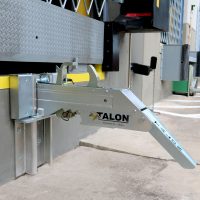Achieving a more than adequate level of safety for employees at the loading dock doesn’t just happen in a vacuum.
Loading dock safety measures take a carefully concerted effort that involves knowing where a facility like a warehouse, distribution center (DC) or manufacturing operation is falling short among all stakeholders and what proactive measures can be taken to make the right improvements.
With the Industrial Truck Association’s (ITA) National Forklift Safety Day (June 11) and associated events in Washington, D.C. just around the corner, now’s the perfect time to focus attention on safety at the loading dock as a key commitment not only for 2024 but also into the future.
 Ongoing commitment to safety at the loading dock
Ongoing commitment to safety at the loading dock
From the company’s inception, Serco has been highly proactive in its commitment to safety at the loading dock. For example, the company addresses safety from two distinct angles: day-to-day equipment use by loading dock personnel and maintenance activities performed by service personnel.
Loading dock equipment features placards that remind employees about safe working practices while maintenance manuals contain numerous reminders for service personnel about safe practices while working on equipment.
While Serco consistently emphasizes the need for loading dock safety, it’s unfortunate that proper precautions are not always put into practice for a variety of reasons.
Fortunately, though, there’s a reassuring flip side to that observation. According to Rich Schlesinger, Director, U.S. Distribution, companies are becoming increasingly proactive than ever before with safety at the loading dock.
“Safety at the loading dock is not as much of an afterthought anymore,” Schlesinger points out. “Serious accidents and near misses are driving the need for increased safety as high-level corporate initiatives, not just individual facilities making safety decisions to keep employees safe.”
It’s well-known that communication issues are one of the leading contributors to accidents at the loading dock. Yard jockeys can incorrectly pull trailers away from the dock when they shouldn’t. And because facilities are moving at higher levels of velocity than ever before, and with an increasing number of loading dock positions at bigger and bigger facilities, the potential for safety risks abound.
Nationwide push toward increased safety
More good news though, says Schlesinger, is that a hard push is underway nationwide in every business sector toward increased safety at loading docks and not just in isolated pockets of the country or in specific sectors as before.
“In the not-too-distant past, dock safety was only important at individual facilities. But safety at the loading dock as a whole has evolved into being critical across all facilities at many companies,” adds Schlesinger. “There is more interest than ever at the corporate level about being proactive about dock safety.”
He further emphasizes, “Whether in food and beverage manufacturing, or distribution centers in general, every dock position will benefit from a restraint because the alternative is just not acceptable anymore.”
 Restraints: a key safety component
Restraints: a key safety component
Hands down, most accidents at the loading dock occur once a trailer is pulled away. That’s why trailer restraints are so important and why they’re talked about so often.
Further complicating matters — and due to pending National Highway Traffic Safety Administration (NHTSA) regulations affecting the design of trailer rear impact guard (RIG) bars — many trailer restraints are no longer compatible or are simply less effective at restraining and releasing trailers causing increased risk. As a result, newer-style five-sided RIG bars with pentagonal cross-sections or tilted configurations require a different approach to trailer restraint design.
To meet this challenge head-on, Serco has introduced the company’s latest innovation in loading dock safety equipment: the Talon trailer restraint.
The newest Serco-branded offering, Talon is the next-generation approach to securing docked trucks, delivering key improvements in safe and effective trailer loading and unloading.
Talon: designed from the ground up
“Talon doesn’t represent just a modification of an existing restraint but was designed from the ground up,” Schlesinger explains. “It represents an entirely novel industry approach to keeping a trailer securely restrained at the loading dock and then releasing it with no issues whatsoever regardless of a RIG bar’s design.”
Instead of a trailer restraint’s hook contacting only two or three sides of a RIG bar, and much like the talons on a bird of prey, the Talon trailer restraint makes complete contact with and surrounds all five surfaces of the pentagonal RIG bar while also eliminating restraint release failure (commonly known as hook pinch).
In addition, many trailer restraints have anywhere from two to eight inches of play (running room) between the restraint and RIG bar during forklift movement. To eliminate running room issues, as a trailer moves toward the loading dock bumpers and engages with the Talon trailer restraint, it will increasingly ratchet itself until it fully grabs the RIG bar and locks it in place. External red and green LED indicators inform the driver whether the restraint is still engaged or disengaged so the trailer can safely depart.
“Bottomline, the use of restraints is the biggest step any facility can make toward increased safety at the loading dock,” Schlesinger stresses.
Importance of dock leveler equipment selection
The next area of concern for safety at the loading dock is levelers. More specifically, levelers are available in both mechanical and powered versions. While less costly than their powered counterparts, mechanical dock levelers do have their specific safety risks.
“Injuries resulting from improper leveler operation use and other ergonomic factors come into play regarding equipment selection,” says Schlesinger. “Compared to a manually-operated dock leveler, for example, a powered dock leveler is obviously safer since it operates with the push of a button.”
Also, a powered dock leveler that is interlocked with a control panel system, means that there is no option for override. A trailer must be properly restrained before the leveler can operate. As for mechanical levelers that don’t have override protection, a vehicle sensor can be employed for added safety.
Seals and shelters prevent slick surfaces
“Even when securely backed into a loading dock position, a trailer is essentially a 53-foot long rain catcher,” Schlesinger points out. “Moisture doesn’t just enter a facility from wind blowing rain into the dock opening. Declines and yard jockeys tilting trailers can result in collected water streaming into the facility.”
That’s why properly installed loading dock seals and shelters are so important. They’ll prevent rain from entering a facility where slips and falls can happen and also hinder forklift operation, due to slick surfaces.
Other safety measures just as critical
In addition to restraints, powered dock levelers as well as loading dock seals and shelters, there are many other approaches that you can take to improve safety at the loading dock,
Adding safety gates and barriers, proper lighting, and enhancing communication methods all work together to make loading docks a safer working environment.
Aftermarket supplier APS Resource is the nation’s leading provider of loading dock repair and replacement parts. To find out more about APS Resource’s product solutions and to learn more about the company, check out the article, Our Top 10 Reasons That Set APS Resource Apart from Other Loading Dock and Door Parts Suppliers.
Look at loading dock safety planning as a whole
“Operations managers have to be safety savvy from day one when they start planning how their loading docks will operate,” says Schlesinger. “When evaluating what you can do with trailer restraints, dock levelers, or seals and shelters to make your facility safer, we recommend that you look at your facility from a holistic standpoint rather than trying to fix just one problem area.”
To find out more about how you can better protect your employees and provide a safer loading dock working environment at your facility, reach out to Serco here, email us at serco@4frontes.com, or call Serco at 800-933-4834.
